Workers in an
INTEGRATING WORLD
World Bank
Overview
Development strategy and workers
Employment in an Integrating
World
Labor policy
Managing Major Changes
Divergence or Inclusion?
Highlights of World Development Report 1995
Duong is a Vietnamese peasant farmer who struggles to feed his family. He earns the
equivalent of $10 a week for thirty-eight hours of work in the rice fields, but he works
full-time only six months of the year-during the off-season he can earn very little. His
wife and four children work with him in the fields, but the family can afford to send only
the two youngest to school. Duong's eleven-year-old daughter stays at home to help with
housework, while his thirteen-year-old son works as a street trader in town. By any
standard Duong's family is living in poverty. Workers like Duong, laboring on family farms
in low- and middle-income countries, account for about 40 percent of the world's labor
force.
Hoa is a young Vietnamese city dweller experiencing relative affluence for
the first time. In Ho Chi Minh City she earns the equivalent of $30 a week working
forty-eight hours in a garment factory-a joint venture with a French firm. She works hard
for her living and spends many hours looking after her three children as well; her husband
works as a janitor. But Hoa's family has several times the standard of living of Duong's
and, by Vietnamese standards, is relatively well-off. There is every expectation that both
she and her children will continue to have a vastly better standard of living than her
parents had. Wage employees like Hoa, working in the formal sector in low- and
middle-income countries, make up about 20 percent of the global labor force.
Françoise is an immigrant in France of Vietnamese origin who works long hours as a
waitress to make ends meet. She takes home the equivalent of $220 a week, after taxes and
including tips, for fifty hours' work. By French standards she is poor. Legally,
Françoise is a casual worker and so has no job security, but she is much better off in
France than she would have been in Viet Nam. Her wage is almost eight times that earned by
Hoa in Ho Chi Minh City. Françoise and other services sector workers in high-income
countries account for about 9 percent of the global labor force.
Jean-Paul is a fifty-year-old Frenchman whose employment prospects look bleak. For ten
years he has worked in a garment factory in Toulouse, taking home the equivalent of $400 a
week-twelve times the average wage in Viet Nam's garment industry. But next month he will
lose his job when the factory closes. Unemployment benefits will partly shield him from
the shock, but his chances of matching his old salary in a new job are slim. Frenchmen of
Jean-Paul's age who lose their jobs are likely to stay unemployed for more than a year,
and Jean-Paul is encouraging his son to work hard in school so he can go to college and
study computer programming. Workers in industry in high-income countries, like Jean-Paul,
make up just 4 percent of the world's labor force.
These four families-two living in Viet Nam, two in France-have vastly different
standards of living and expectations for the future. Employment and wage prospects in
Toulouse and Ho Chi Minh City are worlds apart, even when incomes are adjusted, as here,
for differences in the cost of living. Françoise's poverty wage would clearly buy Hoa a
vastly more affluent life-style. And much of the world's work force, like Duong, works
outside the wage sector on family farms and in the informal sector, generally earning even
lower labor incomes. But the lives of urban workers in different parts of the world are
increasingly intertwined. French consumers buy the product of Hoa's labor, and Jean-Paul
believes it is Hoa's low wages that are taking his job, while immigrant workers like
Françoise feel the brunt of Jean-Paul's anger. Meanwhile, Duong struggles to save so that
his children can be educated and leave the countryside for the city, where foreign
companies advertise new jobs at better wages.
These are revolutionary times in the global economy. The embrace of market-based
development by many developing and former centrally planned economies, the opening of
international markets, and great advances in the ease with which goods, capital, and ideas
flow around the world are bringing new opportunities, as well as risks, to billions of
people. In 1978 about a third of the world's work force lived in countries with centrally
planned economies. At least another third lived in countries weakly linked to
international interactions because of protective barriers to trade and investment. If
recent trends continue, by the year 2000 fewer than 10 percent of workers may be living in
such countries, largely disconnected from world markets.
But rapid change is never easy. In rich and poor countries alike there are fears of
rising insecurity, as technological change, expanding international interactions, and the
decline of traditional community structures seem to threaten jobs, wages, and support for
the elderly. Nor have economic growth and rising integration solved the problem of world
poverty and deprivation. Indeed, the numbers of the poor could rise still further as the
world labor force grows from 2.5 billion today to a projected 3.7 billion in thirty years'
time. The bulk of the more than a billion individuals living on a dollar or less a day
depend, like Duong and his family, on pitifully low returns to hard work. In many
countries workers lack representation and work in unhealthy, dangerous, or demeaning
conditions. Meanwhile 120 million or so are unemployed worldwide, and millions more have
given up hope of finding work.
Yet fears that increased international trade and investment and less state intervention
will hurt employment are mainly without basis. Workers have made great advances in many
countries, especially those that have embraced these global trends, effectively engaging
in international markets and avoiding excessive state intervention. Despite a doubling of
the world's work force over the past three decades, the productivity of the world's median
worker has doubled.
This Report concludes that problems of low incomes, poor working conditions, and
insecurity affecting many of the world's workers can be effectively tackled in ways that
reduce poverty and regional inequality. But to do so will require sound domestic policy
and a supportive international environment. This means that governments must: pursue
market-based growth paths that generate rapid growth in demand for labor, expansion in the
skills of the work force, and rising productivity take advantage of new opportunities at
the international level, by opening up to trade and attracting capital-but manage the
dislocations that international changes sometimes bring construct a framework for labor
policy that complements informal and rural labor markets, supports collective bargaining
in the formal sector, provides safeguards for the vulnerable, and avoids biases that favor
relatively well-off workers, and in those countries struggling with the transition to a
more market-based and internationally integrated pattern of development, try to design the
transition to make it as rapid as possible without excessive or permanent costs for labor.
|
For most households, poor and prosperous alike, income from work is the
main determinant of their living conditions. Of the 2.5 billion people working in
productive activities worldwide, over 1.4 billion live in poor countries, defined as those
with annual income per capita below $695 in 1993. Another 660 million live in
middle-income countries, and the remainder, some 380 million, live in high-income
countries, with annual income per capita above $8,626 in 1993. There are vast differences
in the patterns of employment across these three broad categories of countries. In poor
countries 61 percent of the labor force works in agriculture, mainly tending family farms,
while 22 percent work in the rural nonfarm and urban informal sectors, and 15 percent have
wage contracts, mainly in urban industrial and service employment. In middle-income
countries some 29 percent work on farms, 18 percent in rural and urban informal
activities, and 46 percent in wage employment in industry and services. In rich countries
the bulk of workers have jobs in the formal sector, with roughly 4 percent in agriculture,
27 percent in industry, and 60 percent in services. Some 120 million workers are
unemployed worldwide. Workers in low-income countries dominate the world's agricultural
work force but also, by their sheer numbers, account for nearly half of the world's
industrial workers and about a third of its unemployed. |
Manufacturing wages in a group of export-oriented East Asian economies
rose 170 percent in real terms between 1970 and 1990, while manufacturing employment
increased 400 percent. Wages of agricultural laborers in India rose 70 percent. But
meanwhile industrial wages grew by only 12 percent in a group of Latin American countries
and fell in many Sub-Saharan African countries. . . .
Economic growth is good for workers. This has long been true for those living in what
are now the world's rich countries, and it has been spectacularly true for the newly
industrializing economies (NIEs) of East Asia over the past few decades. Growth has
reduced poverty through rising employment, increased labor productivity, and higher real
wages (Figure 1). Growth also tends to reduce poverty and inequality, including inequality
between men and women. For today's low- and middle-income countries, the fear that growth
will primarily benefit capital, create few jobs, and fail to raise wages is unfounded.
Viet Nam's workers are now some of the poorest in the world. If their country follows the
path of other East Asian successes, they could enjoy a doubling of their labor incomes in
a decade or so.
Market-based development, which encourages firms and workers to invest in physical
capital, new technologies, and skills, is the best way to deliver growth and rising living
standards for workers. Countries that have attempted to help workers by biasing investment
against agriculture and toward industry, protecting the jobs of a favored few industrial
workers against international competition, dictating wage increases, or creating unneeded
jobs in the public sector have failed over the long run-whether in Latin America, the
former Soviet Union, or elsewhere. What any nation's work force needs most is stronger
demand for its services, together with high levels of investment in schooling, training,
roads, and machines. This has worked best where, as in East Asia, governments made good
use of international markets, especially for expanding exports, and gave strong support to
family farming. The public sectors in these economies supported the efficient functioning
of markets by providing a stable macroeconomic environment for saving and investment and
supporting the expansion of economic infrastructure and social services.

Investment in the skills, health, and nutrition of workers is key both to
their welfare and to economic success. But some countries have performed badly despite
investing in schooling. Investment-in physical or in human capital-does not guarantee
growth (Figure 2). The former centrally planned economies of Europe and Central Asia
represent an extreme case of high investment that led first to stagnating and eventually
to collapsing labor incomes.
Market-based, labor-demanding growth also tends to reduce inequality-within countries
and across regions-provided governments ensure broad-based investment in the capabilities
of people and the complementary assets that determine their opportunities. It is true that
the centrally planned economies achieved high degrees of equality and now generally face
some rise in inequality. But the East Asian strategy-of supporting family farms, avoiding
dualistic labor markets, and encouraging vigorous growth in formal employment through
exporting-achieved rapid growth with declining poverty and lower inequality. By contrast,
most Latin American countries have long had highly unequal income distributions, and most
still do, with landholdings heavily concentrated in the hands of a few and growth paths
biased against labor.
Inequalities between men and women, between ethnic groups, and between geographic
regions are particularly tenacious. Women often work more but get paid less than men,
because of a heavier burden of work in the home, less education, or weaker access to
better paying jobs. Indian scheduled castes are confined to low-paying work. Poor regions,
such as the state of Chiapas in Mexico, usually stay relatively poor even when the economy
as a whole expands. Some of these groups do gain from development (in particular, wage
differentials between men and women usually decline), but others miss out. Helping those
left out is one of the toughest problems for policy, for poor and rich countries alike.
From a hard-headed economic perspective, investing in such people may seem a poor risk,
because many are old, socially ill adapted to work, or stuck in backward regions, but
concern for their misery and for social cohesion demands that policy reach out to them.
The longer people are left behind, the harder it becomes to break self-perpetuating
intergenerational cycles of poverty.
The share of manufactures in developing country exports rose from 20
percent to 60 percent between 1960 and 1990. Low- and middle-income countries already
account for almost 80 percent of the world's industrial work force. . . .
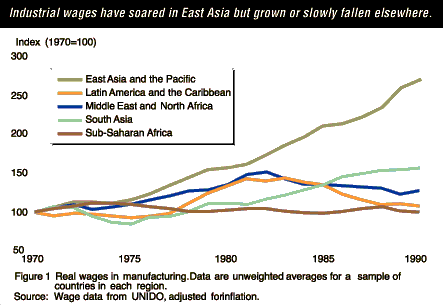 International flows of
goods, services, capital, and people bring new opportunities for most workers. Where
exports have risen fast, so have real wages-by an average of 3 percent per year. Foreign
direct investment, which now accounts for 30 percent of capital flows to low- and
middle-income economies, is creating many new jobs: 60 percent of worldwide growth in the
payrolls of multinational corporations occurred in these countries between 1985 and 1992.
International migration, although so far less of a force for change than either trade or
investment, has usually brought income gains to those who move, higher remittances to
those who stay, and increased production of goods and services in the host countries. International flows of
goods, services, capital, and people bring new opportunities for most workers. Where
exports have risen fast, so have real wages-by an average of 3 percent per year. Foreign
direct investment, which now accounts for 30 percent of capital flows to low- and
middle-income economies, is creating many new jobs: 60 percent of worldwide growth in the
payrolls of multinational corporations occurred in these countries between 1985 and 1992.
International migration, although so far less of a force for change than either trade or
investment, has usually brought income gains to those who move, higher remittances to
those who stay, and increased production of goods and services in the host countries.
Many workers, especially in the farms, factories, and services sectors of Asia, have
seen great gains from international engagement. But for some it feels as though
international integration has increased their vulnerability to volatile international
conditions; others-especially those living in Sub-Saharan Africa-remain largely
disconnected from international market opportunities. And within industrial countries
there is a small but vocal minority who fear they will lose from the introduction of new
technologies, the growth of international trade, and movements of capital and people
across national boundaries.
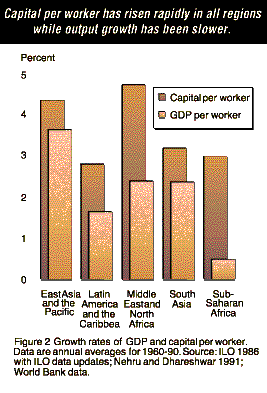 Some workers will
indeed be hurt if they are stuck in declining activities and lack the flexibility to
change. However, international trade, immigration, and capital flows account for only a
small part of the problem faced by laid-off workers in France, or by unskilled men in the
United States who have seen their wages decline for decades, even as the wages of college
graduates continue to rise. More important, restricting trade or capital is not an
effective way of dealing with this problem-a better strategy for any country is to improve
the skills of its people or ease their transition to new jobs, while staying engaged with
the world economy. International migration, in contrast, is always controlled to some
degree. To the extent this is done to reduce conflict while preserving the basic rights of
migrants, it can actually help sustain moderate levels of international migration. Some workers will
indeed be hurt if they are stuck in declining activities and lack the flexibility to
change. However, international trade, immigration, and capital flows account for only a
small part of the problem faced by laid-off workers in France, or by unskilled men in the
United States who have seen their wages decline for decades, even as the wages of college
graduates continue to rise. More important, restricting trade or capital is not an
effective way of dealing with this problem-a better strategy for any country is to improve
the skills of its people or ease their transition to new jobs, while staying engaged with
the world economy. International migration, in contrast, is always controlled to some
degree. To the extent this is done to reduce conflict while preserving the basic rights of
migrants, it can actually help sustain moderate levels of international migration.
In any case, capital now crosses borders ever more rapidly despite the best efforts of
some national governments to control it. But far from rendering national governments
impotent, international capital movements intensify the impact of domestic policy on labor
outcomes, richly rewarding policy when it is sound but punishing it hard when it is
unsound. Faster and broader capital flows and greater openness in trade are making
domestic policy more important for workers. Success breeds success, because good
macroeconomic and structural policies are key to attracting or keeping capital and
achieving the productivity necessary to create competitive jobs at rising wages. But when
policies fail, portfolio investment and local savings leave the scene, and labor suffers
the consequences.
Although 90 percent of developing countries have some form of social
security system, at best it covers only workers in the formal sector, who make up just 15
percent of the labor force in low-income countries, 45 percent in middle-income countries.
. . .
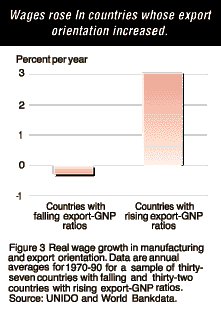 Labor
policies in low- and middle-income countries do not affect the majority of workers who,
like Duong in Viet Nam, work in the rural or the urban informal sector. These are the
poorest workers-often earning less than half what a formal sector employee earns-and
therefore the most in need of protection. Moreover, labor regulations are often not
enforced in many firms that are normally considered part of the modern sector. Labor
policies in low- and middle-income countries do not affect the majority of workers who,
like Duong in Viet Nam, work in the rural or the urban informal sector. These are the
poorest workers-often earning less than half what a formal sector employee earns-and
therefore the most in need of protection. Moreover, labor regulations are often not
enforced in many firms that are normally considered part of the modern sector.
Does this mean that governments in low- and middle-income countries should not bother
to intervene in the labor market, because their policies will not reach those who most
need help and their regulations will not be enforced? The answer is no. Public action can
complement community arrangements and enhance the welfare of informal workers by improving
the environment in which they operate. In the formal sector public action is sometimes
needed to improve market outcomes, enhance equity, and protect vulnerable workers.
Informal and rural workers often must work under more hazardous and insecure conditions
than their formal sector counterparts. Improved working conditions are best achieved not
by legislation but by direct public action affecting the working environment and the
health of workers, in areas such as provision of water and sanitation, roads and drainage
in and near cities, and environmental health. The eradication of onchocerciasis (river
blindness) in large parts of West Africa brought immense reductions in human suffering and
large increases in labor supply. Informal income security arrangements can be complemented
by public transfer programs: public works are usually the best transfer method for
able-bodied men and women. In India's Maharashtra State, for many years rural workers were
guaranteed work in public works schemes at the local wage rate.
For the formal sector, collective bargaining between firms and independent unions is an
effective way to determine wages and working conditions. Yet governments have often
repressed unions, as in the Republic of Korea until the 1980s, or politicized the
bargaining process, as in Bangladesh today. Sometimes, as in Indonesia, they have
responded to pressures for independent unions by directly raising standards, such as
minimum wages, potentially at the cost of employment. Governments do need to establish the
rules for labor-management negotiations, spelling out the rights of workers and firms,
establishing dispute resolution mechanisms, and promulgating basic health and safety
regulations, which unions can monitor. Where unions cover only a small proportion of the
work force, as they do in most low- and middle-income countries, decentralized bargaining
under conditions of competitive output markets produces the best results. This precept has
long applied in Japan and Hong Kong and applies now in Chile and Korea.
Direct government intervention makes sense in dealing with child labor and in other
cases where the market may produce adverse outcomes, such as discrimination against women.
But legislation alone has been ineffective. It needs to be complemented by other policies
such as low-cost education and better access for women to formal sector jobs. India has
sound child labor laws, yet millions of children are working, often in hazardous
conditions. Child labor is partly a reflection of poverty. But it is not necessary to wait
for a reduction in the poverty rate to tackle the most life-threatening and demeaning
aspects of child labor. In the town of Pagsanjan in the Philippines, civic action
dramatically reduced child prostitution. In Brazil, India, and the Philippines, local
action, with public support, is improving the health status of working children and giving
them greater educational opportunities.
Governments also have to set policy for public employment. Many public sector workers
work hard and productively. But in many low- and middle-income countries, notably in
Sub-Saharan Africa and the Middle East, the quality of public service has suffered as its
ethos has been destroyed by a combination of overstaffing, inadequate pay, and weak
governance. Restoring levels of pay and reducing the number of public workers are often
essential reforms, to be combined with improvements in the recruitment, promotion, and
accountability of civil servants, teachers, nurses, and policymakers. The redefinition of
the role of the state makes it all the more important that governments be effective in
those areas where they do stay involved.
If support for the rights of workers to form unions and to bargain collectively and
support for the reduction of child labor make sense in a national context, should these
principles be linked to international trade agreements, with sanctions for their
violation? Advocates of linkage make a distinction between "core" standards,
which for many would be akin to basic rights and do not directly raise labor costs, and
other standards, such as minimum wages, that are a direct function of the level of
development. Such a division is sound, and there is a case for international concern over
core standards. However, it is best to keep multilateral trade agreements confined to
directly trade-related issues, to prevent protectionist interests from misusing such links
to reduce the trade that workers in low- and middle- income countries need if their
incomes are to rise. As the history of trade reform illustrates, even well-intentioned and
rationally designed discretionary trade measures can be captured by protectionist
interests.
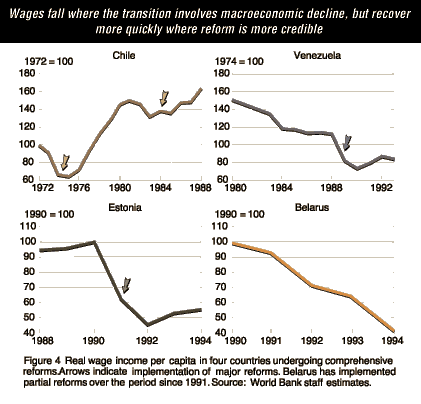 Of the world's 2.5
billion workers, 1.4 billion live in countries struggling with transitions from state
interventionism, high degrees of trade protection, or central planning. . . . Of the world's 2.5
billion workers, 1.4 billion live in countries struggling with transitions from state
interventionism, high degrees of trade protection, or central planning. . . .
Many developing and transitional economies are struggling with one or both of two major
changes in their development strategies: from protection to greater integration with
international markets, and from massive state intervention to a market economy in which
the state plays a smaller role in allocating resources. These changes can have a powerful
labor market dimension. Their key characteristic is an acceleration in the destruction of
unviable jobs and the creation of new ones. The process is often accompanied by
macroeconomic decline and by a sharp drop in the demand for labor nationwide. In the short
term, workers often feel the pain as real wages fall, unemployment rises, and employment
shifts into informal activities. In Argentina, Bolivia, Chile, and Mexico, real wages fell
by a third or more before recovering. In Bulgaria, the Czech Republic, Poland, Romania,
and Russia, real wages fell between 18 and 40 percent in the first year of transition; in
some countries, including Bulgaria and Poland, unemployment rose from negligible levels to
15 percent or more. But in Ghana and China wages rose during the adjustment process, and
unemployment remained low.
Economic reform can create opportunities for some workers but have wrenching effects on
others. Even the best-designed reforms produce gainers and losers in the short term.
Moving the economy as quickly as possible to the new growth path is key to minimizing the
pain and social costs of adjustment; macroeconomic stability and credibility of the
overall reform package are therefore critical. Countries such as Chile and Estonia have
done relatively well on these scores and have brought about-or are bringing
about-recoveries in wages and employment. In contrast, Belarus and Venezuela have faltered
and suffered declines or stagnation in wages and employment (Figure 4).
Is a strategy of gradual transition better for workers? Where initial conditions allow
gradual job destruction without jeopardizing the reform that is needed to generate new
jobs, gradualism makes sense. China exemplifies the truth of this proposition, but that
country enjoyed a large margin for job expansion, first in agriculture and then in
quasi-private industry, which could help finance the cost of the relatively inefficient
state sector. In most other countries either macroeconomic imbalance or the costs of
inefficient sectors make gradualism a nonstarter.
Microeconomic policies that affect the mobility and incomes of workers can play a major
role both in influencing the overall pace of change and in safeguarding the welfare of
workers over the transitional period. Good policy will generally involve action in three
areas: enhancing mobility, reducing income insecurity, and equipping workers for change.
These are highly complementary. Increased mobility will often involve measures to allow
job destruction, including large layoffs from the public sector, to run its course. In
many countries measures to separate entitlement to social services from employment and to
liberalize housing markets are required. But it is also important to consider the needs of
those at risk of steep income declines. Income transfers can play an important role here.
Retraining can help certain groups of workers but is unlikely to provide a panacea.
About 99 percent of the 1 billion or so workers projected to join the world's labor
force over the next thirty years will live in what are today's low- and middle-income
countries. Some groups of relatively poor workers have experienced large gains in the past
thirty years-especially in Asia. But there is no worldwide trend toward convergence
between rich and poor workers. Indeed, there are risks that workers in poorer countries
will fall further behind, as lower investment and educational attainment widen
disparities. Some workers, especially in Sub-Saharan Africa, could become increasingly
marginalized. And those left out of the general prosperity in countries that are enjoying
growth could suffer permanent losses, setting in motion intergenerational cycles of
neglect.
There is a substantial risk that inequality between rich and poor will grow over the
coming decades, while poverty deepens. But it need not be so if countries choose the right
international and domestic policies. Preserving open trading relations, preventing rich
country fiscal deficits from crowding out investment elsewhere, and delivering high and
stable growth in the high-income countries will maintain global demand and help head off
any protectionist pressures in rich countries that might result from persistently high
unemployment. Of even greater importance are domestic policies that promotes
labor-demanding growth- and sound labor policy.
Governments and workers are adjusting to a changing world. The legacy of the past can
make change difficult or frightening. Yet realization of a new world of work, in which all
groups of workers are included in a dynamic of rising incomes, better working conditions,
and enhanced job security, is fundamentally a question of sound choices-in the
international and the domestic realm. The right choices involve using markets to create
opportunities, taking care of those who are vulnerable or left out, and providing workers
with the conditions to make their job choices freely, bargain over their conditions of
work, and take advantage of better educational opportunities for their children. Duong,
Hoa, Françoise, and Jean-Paul-and millions of workers like them-all have a powerful
interest in good policy. They and their families have to live with the consequences.
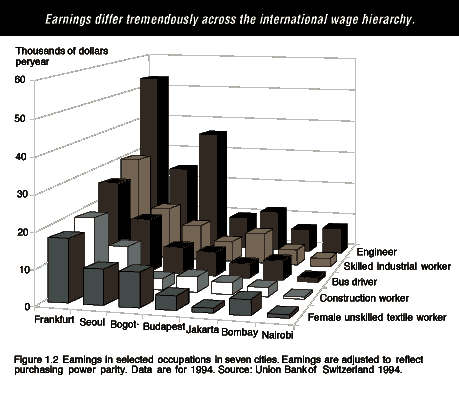 How much better paid are workers in one
country than their counterparts in another? Even after adjusting for differences in the
purchasing power of currencies, an engineer in Frankfurt, Germany, earns about fifty-six
times the wages of an unskilled female textile worker in Nairobi, Kenya, who in turn earns
several times the wages of rural workers in her country. Part of the gap between the
highest- and the lowest-paid is due to differences in pay for different jobs within
countries: engineers, for example, earn more than unskilled textile workers in every
country. But part is also due to international differences in returns to similar work:
engineers in countries with high GDPs, such as Germany, bring home higher wages than do
engineers of equal skill in Hungary or India. How much better paid are workers in one
country than their counterparts in another? Even after adjusting for differences in the
purchasing power of currencies, an engineer in Frankfurt, Germany, earns about fifty-six
times the wages of an unskilled female textile worker in Nairobi, Kenya, who in turn earns
several times the wages of rural workers in her country. Part of the gap between the
highest- and the lowest-paid is due to differences in pay for different jobs within
countries: engineers, for example, earn more than unskilled textile workers in every
country. But part is also due to international differences in returns to similar work:
engineers in countries with high GDPs, such as Germany, bring home higher wages than do
engineers of equal skill in Hungary or India.
These differences in pay are largely due to differences in labor productivity: the
quantity and value of workers' contribution to output. With development, workers become
more productive in the activities in which they specialize: their skills advance, the
amount of capital supporting each worker increases, and the organization of their work
improves. Workers also gain from economy-wide growth in productivity that leads to higher
wages as labor becomes relatively more scarce. The Report discusses how the pattern of
development can speed or slow this process.
 Long-term economic growth is good for
workers. In low- and middle-income countries, growth in the economy is strongly correlated
with wage growth in both agriculture and manufacturing. Rising GDP means rising value
added per worker, and if value added per worker is rising, wages are likely to rise as
well. The Report explores the conditions under which low- and middle-income economies can
embark on a path of sustained and self-reinforcing growth together with rising wages. Long-term economic growth is good for
workers. In low- and middle-income countries, growth in the economy is strongly correlated
with wage growth in both agriculture and manufacturing. Rising GDP means rising value
added per worker, and if value added per worker is rising, wages are likely to rise as
well. The Report explores the conditions under which low- and middle-income economies can
embark on a path of sustained and self-reinforcing growth together with rising wages.
|
The integration of national and regional
markets is driven by falling costs of transportation and communications, which are
bringing together goods, capital, people, and ideas faster and more cheaply than at any
time in history.
Trade has nearly doubled as a share of world GDP since 1970. Industries directly or
indirectly related to exports already employ about one-sixth of the combined work force of
the developing and transitional countries.
Annual foreign capital flows have risen to roughly 9 percent of the GDPs of developing
and transitional countries. Had these countries been able to retain all the capital
inflows they have received over the years, they would now amount to some 11 percent of
their total capital stocks-but this outflow represents only 2 percent of the capital
stocks of the industrial countries.
Migration is the laggard in this story: flows of migrants into and out of developing
and transitional countries, most of them in search of work, are no greater today than in
1970. Persons living outside their country of origin make up only 2 to 3 percent of the
combined populations of the low- and middle-income countries, and less than 1 percent of
that of the industrial countries.
All these forms of integration are creating a global labor market where wage and
employment decisions in one country are increasingly influenced by conditions and
decisions in others. The Report assesses the consequences of this growing interdependence
for workers, many of whom, rightly or wrongly, see increased exposure to the global
economy as a threat to their livelihoods.
|
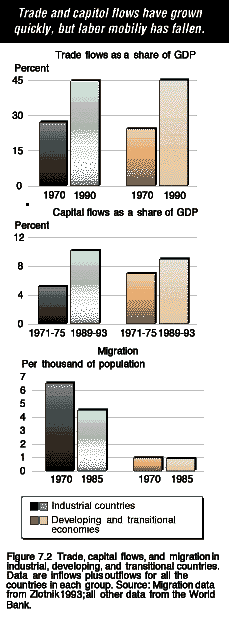 |
|
|
Box 6.1 Do lower wages for women indicate discrimination?
Not all of the observed gender wage gap necessarily represents discrimination in the
labor market. A lower wage for women in a given economy may reflect their lower
productivity in wage employment. Women in developing countries often have less schooling
and on-the-job experience than men, and estimates of wage discrimination need to account
for such factors. One method is to estimate returns to certain attributes and
characteristics, such as schooling, experience, and occupation, separately for males and
females, and then decompose the observed wage differential into two parts. The first shows
the component of the wage differential due to women actually having "worse"
attributes and characteristics than men, whereas the second addresses what women would be
earning if they had the same attributes as the men in the economy. This second measure
points to discrimination, if women's earnings are still less than those of men.
The most striking examples of the use of this methodology come from countries such as
Ecuador, Jamaica, and the Philippines. Women in those countries actually have more
education and experience, on average, than men but get paid between 20 and 30 percent
less. In these countries, women would actually have higher wages than men were their
contributions valued equally by the labor market.
The decomposition analysis has some problems: for example, using "years since
school" as a measure of experience may misstate the nature of women's experience, or
the use of broad occupational categories may obscure a tendency for women to hold lower
status jobs than men within the same occupation. Nevertheless, results from a wide range
of developing countries make it clear that labor markets do discriminate against women
workers. |

Women generally work fewer hours than men in market-related activities, but longer
hours overall, devoting much more time than men to childrearing, household maintenance,
and, in many areas, fuel and water gathering. When women do work for wages, their wages
tend to be lower than for men, in part because they are disproportionately employed in the
informal sector and in part because they tend to have less education than men.
The Report discusses policies that can improve the welfare of working women by
improving their education and their position in the labor market.
| Where union membership is low, as it is
in many developing countries with small formal sectors, the benefits of unionization-which
usually include higher wages, and often better working conditions as well-are enjoyed by a
relative few. In those developing countries where the union wage premium has been studied,
unionized workers made from 10 to 30 percent more than their nonunionized counterparts.
Where unions also have some monopoly power, these benefits to the minority come at the
expense of the majority of consumers, who must pay higher prices for the goods and
services the unionized firms produce. And the unionized workers' higher wages lead their
employers to hire fewer workers, thus increasing the supply of labor to the nonunion
sector and depressing employment there. |
 |
|
However, the presence of a union can enhance productivity and efficiency in the
workplace. Workers protected by unions may be more confident that management will not
appropriate all the gains from any contribution they make toward more efficient workplace
organization.
The Report examines the positive and negative effects of labor unions and how the legal
and market framework within which they operate can maximize their positive influence.
|
 |
|
Will the twenty-first century see a widening of the already enormous gap in the returns
to labor between the richest and the poorest countries? Or will the turnabout in
development strategy on the part of so many formerly closed and centrally planned
economies contribute to a convergence of incomes?
The Report presents projections generated by a global economic model for 2010 under two
contrasting scenarios. The first is a "divergent" scenario in which investment
and educational attainment in all major regions remain anemic, labor productivity rises
only weakly, and countries fail to realize the Uruguay Round's promise of reduced
international trade barriers. The second is a more optimistic "convergent"
scenario in which investment, schooling, and hence labor productivity rise in all
regions-thanks in part to sound policy choices-and barriers to international transactions
fall.
The convergent scenario depicts an international distribution of wages in which poorer
groups of workers begin to catch up with wealthier ones: the ratio between the wages of
the poorest and richest groups falls from about sixty to one now to about fifty to one in
2010, whereas in the divergent scenario it increases to seventy to one. But it is clear
that international income differences, which have been widening since the last century,
will not soon disappear even under the more optimistic scenario. The Report fleshes out
these general scenarios with a region-by-region assessment of the prospects for change.
|
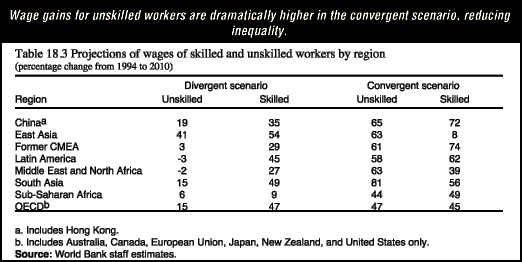 |
|
 International
International



